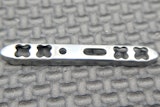Remember BattleBots? Imagine a smarter and less sinister robot competition that fosters youth interest in engineering.
FIRST Robotics is a revolutionary engineering competition created by inventor Dean Kamen. FIRST (For Inspiration and Recognition of Science and Technology) is dedicated to promoting the fields of engineering, math, and science to kids through building robots. Not only is FIRST about getting kids into engineering and technology, but turning them into future leaders of these fields.
The Basics
There are three FIRST competitions: FIRST Lego League (FLL), FIRST Tech Challenge (FTC), and FIRST Robotics Competition (FRC).
FLL is for the youngest generation of engineers in which grade school kids build Lego-based, autonomous robots and program them with Lego Mindstorms technology.
FTC is for high school kids, designed for head-to-head competition using a sports model. Students design, build, and program robots to compete in an alliance format against other teams.
FRC is the penultimate of the FIRST competitions. These robots are the largest of the competitions, and the kit changes every year. The students receive their kit in early January, giving them six weeks of design time before they have to qualify for the international competition in St. Louis.
All of the FIRST teams are required to approach their projects like real-world problems. “Teams form, raise money, and essentially run a business to participate in a regional event,” explains Carol Popovich, FIRST community relations representative for Microchip Technologies. “One of the incredible aspects of being on a FIRST team is the eligibility for over $14M in scholarships.”
Robin Saitz, SVP Solutions Marketing at PTC explains, “FIRST is based in reality, applying the technology in a real-world situation.” The competitions create engineering awareness among kids, as well as provide them with further opportunities to succeed in the math and science fields.
FRC: In Depth
The kids receive their kits and information about the game on January 7, 2012. After that, they create a budget and execute deadline-oriented design and engineering as they have just six weeks to design, build, test, and ready their robot for competition.
As kids design and develop their robots, they are responsible for staying within a tight budget. They also need to market themselves within the community for cash to pay for that budget. As their design comes to fruition, testing and programming becomes a challenge as well. With realistic business constraints and painfully tight deadlines, “FIRST focuses on the whole kid,” explains Robin Saitz. “They absolutely learn engineering skills, but also learn life skills and business skills.” Like any real engineering project there usually isn’t enough money or time to complete the task at hand.
The robots will be officially ‘bagged and tagged’ on February 21, 2012. Depending on their area, the teams will then be involved in preliminary, regional, and state championships to determine who goes to the big show held in St. Louis, MO from April 25 to 28, 2012.
In the games, each team pairs with another team in an alliance to complete the tasks at hand. Just like the real world, these alliances don’t last forever, in fact, they only last one series before the teams are forced to create new alliances for the next round of competition. The format teaches the kids what Dean Kamen calls "gracious professionalism," promoting healthy competition in a friendly atmosphere
PD&D will be following several teams from start to finish as they build competition-ready FRC robots. PD&D's daily e-newsletter will have videos and blog entries featuring FIRST competitors and their road to the international competition.
Engineering Community
The obvious benefit of FIRST is an emerging interest in engineering amongst kids. “Kids who participate in FIRST are the next generation of problem solvers, and it’s not a secret that there is a shortage of engineers,” explains Saitz. “We [PTC] are getting kids up to speed on software through hands-on workshops,” and that is only the tip of the iceberg.
“This raises the level of education for everybody,” says Carol Popovich. The program becomes incredibly valuable across the board. “Microchip, for years, has offered internships to these students because these kids have the skills that we are looking for in employees. This is where the industry needs to be.”
Past FIRST participants have left high school with an education and influence that has driven them toward careers in engineering. The FIRST competition drives kids along with their mentors, teachers, and professional engineers to innovate and experience a new way of thinking.
FIRST looks to showcase big thinkers and engineers as role models, rather than the professional athletes and movies stars who are all-too-often idolized. The kids are thrust into a real-life engineering experience from the first day.
As the competition gains momentum, FIRST has also gained the attention of several influential faces around the world. With industry support from organizations like PTC and Microchip Technologies, promotional videos featuring Morgan Freeman, and an ABC concert event produced by Will.i.am from The Black Eyed Peas, FIRST is looking to grow exponentially.
As Microchip President and CEO Steve Sanghi says, “FIRST isn’t about building robots, it’s about life skills.” Benefitting from industry and Hollywood endorsement, FIRST is growing the engineering community and creating smart kids. Scholarships and hands-on experience make the FIRST competitions incredibly valuable to students, but even more valuable to their potential, future employers.























